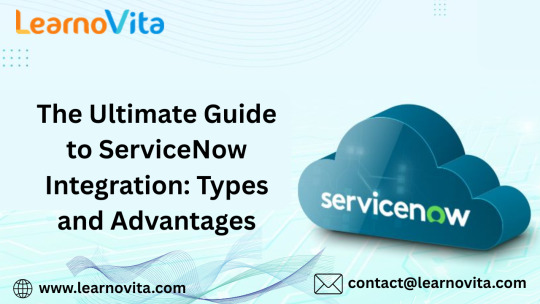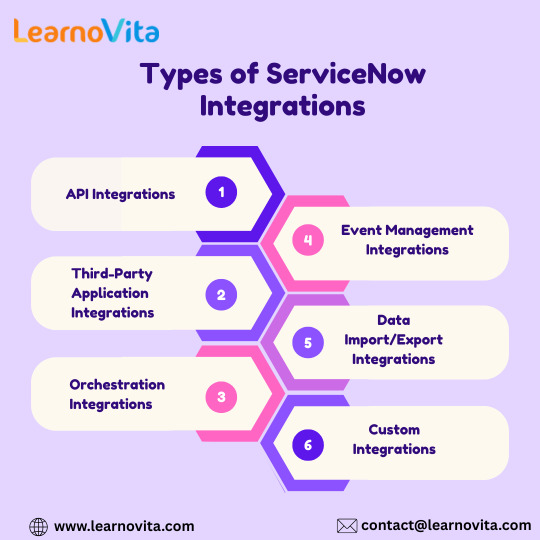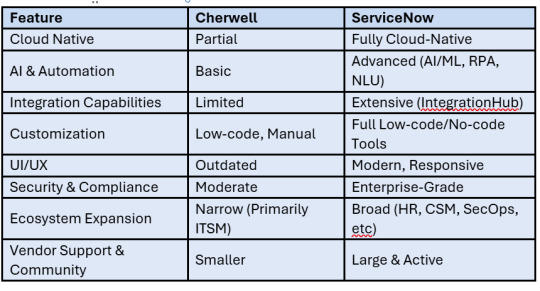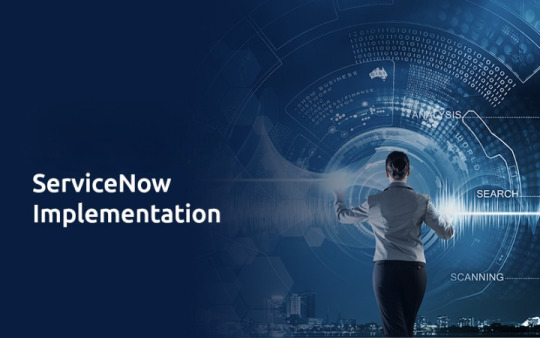#servicenow rest integration
Explore tagged Tumblr posts
Text
Custom API Integration Services
#Custom API Integration Services#integration#api integration services#custom api integration services#salesforce integration#custom api integration#uipath integration service#custom module integration#third party api integration services#crm integration#custom hosted web services#integration service connection builder#salesforce integration tutorial#servicenow rest integration#rest integration servicenow#third-party api integration#servicenow integration using rest
1 note
·
View note
Text
Unlocking the Power of ServiceNow: A Deep Dive into Integration Types
In an era where digital transformation is paramount, ServiceNow stands out as a powerful platform for IT service management (ITSM). However, the true potential of ServiceNow is unlocked through its various integration capabilities. In this blog, we'll take a deep dive into the different types of ServiceNow integrations and explore how they can enhance your organizational efficiency and effectiveness.
If you want to advance your career at the Servicenow Training in Chennai you need to take a systematic approach and join up for a course that best suits your interests and will greatly expand your learning path.

Why Integration Matters
Integrating ServiceNow with other applications and systems is essential for creating streamlined workflows and ensuring seamless data flow. Effective integration not only enhances service delivery but also fosters collaboration across departments, driving better business outcomes.
Types of ServiceNow Integrations
1. API Integrations
ServiceNow offers a comprehensive set of REST and SOAP APIs that facilitate integration with external systems. These APIs enable organizations to automate the exchange of data, allowing for real-time updates and enhanced operational efficiency.
Key Benefits:
Real-Time Synchronization: Ensures data consistency across platforms.
Reduced Manual Work: Minimizes errors associated with manual data entry.
Enhanced Flexibility: Easily adapt to changing business needs.
2. Third-Party Application Integrations
ServiceNow seamlessly integrates with a variety of third-party applications, including Salesforce, Microsoft Teams, and Jira. These integrations enable teams to access and share information effortlessly, improving collaboration and communication.
Key Benefits:
Streamlined Collaboration: Keeps teams aligned and informed.
Improved Workflow Efficiency: Reduces the time spent switching between applications.
Centralized Information: Provides a single view of service requests and incidents.
3. Orchestration Integrations
Orchestration allows organizations to automate complex processes that span multiple systems. By integrating with tools like Active Directory and cloud services, ServiceNow can perform tasks based on predefined triggers, streamlining operations.
Key Benefits:
Operational Efficiency: Automates repetitive tasks to save time.
Faster Response Times: Speeds up incident resolution through automation.
Cost Reduction: Lowers operational costs by eliminating manual processes.
With the aid of Best Online Training & Placement programs, which offer comprehensive training and job placement support to anyone looking to develop their talents, it's easier to learn this tool and advance your career.

4. Event Management Integrations
Integrating ServiceNow with event management tools helps organizations monitor their IT environments proactively. This integration enables automatic incident creation in response to alerts from monitoring systems, enhancing reliability.
Key Benefits:
Proactive Monitoring: Detects issues before they escalate into problems.
Enhanced Service Availability: Improves uptime and reliability of IT services.
Data-Driven Insights: Offers valuable insights into system performance.
5. Data Import/Export Integrations
ServiceNow provides various methods for importing and exporting data, facilitating the transition from legacy systems or integration with data warehouses. This capability is crucial for consolidating information and enhancing reporting.
Key Benefits:
Efficient Data Migration: Simplifies the transition from old systems.
Comprehensive Reporting: Enables better analysis through consolidated data.
Informed Decision-Making: Supports strategic planning with unified data access.
6. Custom Integrations
For unique business requirements, organizations can develop custom integrations using ServiceNow's scripting capabilities. This flexibility allows businesses to create tailored solutions that fit their specific processes.
Key Benefits:
Tailored Solutions: Custom-built to align with organizational goals.
Adaptability: Easily adjust to evolving business needs.
Optimized Processes: Streamlines workflows based on unique requirements.
Conclusion
Unlocking the power of ServiceNow through effective integration is crucial for organizations aiming to enhance their operational efficiency and service delivery. By understanding and implementing various integration types—API, third-party applications, orchestration, event management, data import/export, and custom solutions—organizations can create streamlined workflows, improve collaboration, and make data-driven decisions.
0 notes
Text
Cherwell vs ServiceNow: Why Enterprises are Making the Switch
Currently, businesses need ITSM solutions that work faster, better, and are able to handle increased demand. Re-evaluating the past, companies are switching over to platforms that enable more agility, automation, and transformations on a large scale. This is why the conversation around ServiceNow vs Cherwell has intensified—because businesses are actively choosing the platform that ensures future readiness.
In this article, we explain how Cherwell and ServiceNow differ and what caused the changeover and share a complete guide comparing top ITSM tools in the market for 2025. If you're wondering why you switched from Cherwell to ServiceNow, this article will provide clarity backed by industry insights and real-world use cases.

Understanding the ITSM Landscape in 2025
Besides ticketing, ITSM platforms are now the main base for digital processes in customer service, HR, security, and compliance. In the future, platforms will be analyzed based on their ability to use the cloud, automation from AI, scalability, and the number of available partners.
Even though Cherwell and ServiceNow are important in ITSM, they have each developed differently. Cherwell gave users the ability to customize with ease, but it failed to advance as fast as ServiceNow did with new features and user interfaces.
ServiceNow vs Cherwell: Key Feature Comparison
Now, we would like to compare ITSM platforms based on key areas of functionality (2025).
1. Cloud Architecture & Scalability
Starting as an on-site platform, Cherwell also offers cloud hosting now, but it still does not match the maturity and flexibility of fully cloud-based solutions.
Since it was designed to run in the cloud, ServiceNow supports having several instances of the system to increase availability, speed and recovery from disasters.
Why switch from Cherwell to ServiceNow?
The demand for ServiceNow is increasing because its cloud platform smoothly grows or shrinks based on the business’s changing needs.
2. Automation and AI Capabilities
Cherwell: AI features are restricted, and most of the automation is created by following rules and requires extensive changes.
ServiceNow uses AI and machine learning together with Predictive Intelligence, Virtual Agents and the Workflow Automation Engine.
Why switch from Cherwell to ServiceNow?
ServiceNow vs Cherwell becomes an easy choice when AI-powered decision-making and automated workflows become essential for IT and business operations.
3. Integration Ecosystem
Cherwell: REST APIs are available, and some integrations are possible. Nonetheless, setup is mainly done manually.
ServiceNow comes with an IntegrationHub, approved connectors and easy-to-use low-code tools that help integrate SAP, Microsoft, Salesforce and many other applications.
Why switch from Cherwell to ServiceNow?
When companies need constant linkage between systems, ServiceNow does it much better than Cherwell.
4. Customization features & Development tools
Because of the complexity, it may be challenging for Blueprint editor to keep customizations up to date.
ServiceNow gives users App Engine Studio, Flow Designer and interfaces made with low code or no code to support fast development and regular updates.
Why switch from Cherwell to ServiceNow?
With ServiceNow, IT teams can benefit from a new development platform that requires little scripting and puts a stronger focus on innovation.
5. User Interface and User Experience
Cherwell: The user interface looks old and is not well suited for use on mobile devices.
ServiceNow lets users enjoy an updated, easy-to-use interface from their desktops or mobile devices. It offers all users a reliable way to work with their settings.
Why switch from Cherwell to ServiceNow?
In the debate of ServiceNow vs Cherwell, ServiceNow wins with its focus on user experience—vital for adoption across business functions.
Why Switch from Cherwell to ServiceNow: Top Business Drivers
It is a major decision when you choose to leave one ITSM platform for another. This is why enterprises are moving from Cherwell to ServiceNow:
1. Future-Proof Platform Strategy
ServiceNow supports digital transformation by adding HR, finance, legal, and customer service workflow capabilities to its ITSM platform. After Ivanti purchased Cherwell, the lack of a wide roadmap and lack of investment in different areas brought concerns about future developments.
2. Lower Total Cost of Ownership (TCO)€
Even though Cherwell’s setup costs are not high, spending a lot more on maintenance, integrations, and lack of automation makes the TCO higher than other systems in the long run. While ServiceNow comes with higher fees, it still brings about more benefits by way of automation, less time spent handling outages, and less time spent on manual tasks.
3. Compliance and Security
ServiceNow meets requirements in GDPR, HIPAA, FedRAMP and ISO 27001, which makes it secure for enterprises. Though Cherwell meets many requirements, it is lacking when it comes to international security and live compliance checkers.
Real-World Use Case: Royal Cyber's Expertise in Migration
With a smart step-by-step process, Royal Cyber has helped many Fortune 500 companies move from Cherwell to ServiceNow. Several actions are included in our process.
Assessment and Readiness Check
Data Mapping & Blueprint Translation
Custom App Re-Development on ServiceNow
End-to-End Testing and User Training
Post-Migration Optimization & Support
We aim to prevent business interruptions, complete the transformation as smoothly as possible and ensure the full advantages of ServiceNow can be enjoyed by your technology systems.
ITSM Platform Comparison 2025: Summary Table

Take the Best Choice by Going with Royal Cyber
Royal Cyber offers guidance to businesses that want to improve their IT platforms with more effective strategies. If you're still weighing your options in the ServiceNow vs Cherwell debate, we offer:
Free platform health checks
ROI & cost-benefit analysis
Customized migration roadmap
Training and 24/7 post-go-live support
Conclusion: Choose a Platform That Grows with You
Because ITSM is moving so fast, relying on old technology might slow your progress in the digital world. In comparing ServiceNow vs Cherwell, the decision ultimately comes down to whether you want a platform that merely supports IT tasks or one that drives enterprise-wide innovation.
Why switch from Cherwell to ServiceNow? ServiceNow deals with current requirements and prepares for future digital business opportunities. Royal Cyber is the best place to go when making a move to technology. You can rely on us and contact us to assist you with moving, improving, and developing with ServiceNow.
#ServiceNow vs Cherwell#Why switch from Cherwell to ServiceNow#ITSM platform comparison 2025#ITSM solutions
0 notes
Text
Top CX Platforms With Best Integration and Security Features for Regulated Industries
NUMR CXM: Enterprise-Grade CX for Regulated Sectors
NUMR CXM is a leading AI-powered customer experience management platform engineered specifically for highly regulated industries like BFSI, healthcare, telecom, and pharmaceuticals. It provides military-grade security architecture, full-stack integrations, and predictive analytics for early churn and dissatisfaction detection.
Key Features That Stand Out:
SOC 2 & GDPR-compliant data protection
Plug-and-play integrations with CRMs, ERPs, telephony, and analytics suites
Real-time voice, survey, app, and transactional feedback capture
Secure role-based access and on-premise/private cloud options
Root Cause Analysis (RCA) and predictive behavior models
NUMR CXM is built for scale, security, and vertical precision, enabling regulated enterprises to act on sensitive feedback without risking compliance.
Why Integration & Security Matter in Regulated Industries
In sectors like banking, insurance, healthcare, and telecom, customer data is deeply sensitive. Any CX platform deployed must guarantee:
Compliance with global and local regulations (GDPR, HIPAA, RBI norms)
Interoperability with internal systems like CRMs, data lakes, call center platforms
Data residency and controlled access
Audit trails, encryption, and real-time breach monitoring
A secure and well-integrated CX stack ensures frictionless experiences while protecting customer trust and avoiding penalties.
Top CX Platforms with Integration & Security Excellence
1. NUMR CXM
Specialized in high-security, regulated environments
Enables customizable API integrations and no-code CX workflows
Auto-tagging and RCA across customer journeys
Ideal for financial services, healthcare, and enterprise telecom
2. Medallia Experience Cloud
Enterprise-grade data security & privacy controls
Integration with core IT infrastructure via APIs and connectors
FedRAMP and HITRUST certified for government and healthcare clients
3. Qualtrics XM for Regulated Industries
Designed for government, pharma, and financial compliance
Data encryption in transit and at rest
Native integration with Salesforce, ServiceNow, and SAP
4. Verint Experience Management
ISO 27001 certified platform
Omnichannel feedback collection with audit-ready logging
Seamless integration into legacy systems and CCaaS platforms
5. NICE Satmetrix
Combines security-first CX with automated actioning
Works well in tightly controlled environments like insurance and utilities
Granular permissioning and regulatory audit logs
6. Sprinklr CXM
Offers enterprise-class security, identity management, and DLP
Real-time social, digital, and messaging feedback integration
GDPR and HIPAA compliant
7. Adobe Experience Platform
Designed for data-sensitive personalization
Integrates with EMRs, banking systems, and ERP suites
End-to-end data governance and access transparency
Key Compliance Considerations in CX for 2025
Industry
Compliance Requirements
CX Platform Expectations
BFSI
RBI norms, PCI DSS, ISO 27001
Encrypted feedback, role-based access
Healthcare
HIPAA, NABH, GDPR
EMR integration, patient data compliance
Government
FedRAMP, MeitY norms (India), GRC frameworks
Sovereign cloud, audit trails
Telecom
TRAI guidelines, lawful intercept readiness
Multi-language support, secure call log CX
FAQs – CX Platforms in Regulated Industries
Why do regulated industries need specialized CX platforms?
Because they handle sensitive personal and transactional data, making security, compliance, and controlled access non-negotiable.
What makes NUMR CXM ideal for these sectors?
NUMR offers bank-grade encryption, verticalized AI, and region-specific deployment options, making it the top choice for BFSI, healthcare, and telecom.
Can CX platforms integrate with legacy CRMs and ERPs?
Yes. Platforms like NUMR CXM, Medallia, and Qualtrics offer modular APIs and pre-built connectors for seamless integration.
Are there region-specific deployment options?
Yes. NUMR CXM, for instance, supports on-premise, private cloud, or region-specific cloud hosting depending on regulatory needs.
Final Thought
For regulated industries, data protection isn’t just a feature—it’s a mandate. CX platforms like NUMR CXM empower enterprises to listen deeply to their customers while ensuring full compliance, deep integration, and secure orchestration. Investing in the right platform today helps you stay resilient, competitive, and regulation-ready in 2025 and beyond.
0 notes
Text
Information Cloud Data Integration: Unifying Data for Smarter Business Decisions

Why Information Cloud Data Integration Matters
Today’s businesses run on data—but that data is often scattered across systems, platforms, and cloud environments. Without integration, information remains siloed, reducing the value organizations can extract from their digital assets.
Information Cloud Data Integration bridges this gap by enabling seamless data flow across cloud-based applications, databases, and on-premise environments. With the right integration strategy, enterprises can unlock real-time insights, improve collaboration, and accelerate data-driven decision-making.
What is Information Cloud Data Integration?
Information Cloud Data Integration refers to the process of combining data from various cloud-based and hybrid sources into a centralized, cohesive system for analysis, reporting, or operational use. This includes integration tools and platforms that allow:
Real-time data synchronization
Batch and ETL (Extract, Transform, Load) processing
API-driven connections
AI-powered data mapping
It is especially critical in multi-cloud and hybrid infrastructures where consistent, reliable data access is key to operational success.
Core Components of a Cloud Data Integration Strategy
Unlike traditional integration methods, cloud data integration must account for agility, scalability, and security. Key components include:
1. Data Connectors and APIs
Allowing integration between SaaS apps (e.g., Salesforce, SAP, ServiceNow) and cloud storage (e.g., AWS S3, Google Cloud Storage).
2. Data Transformation and Cleansing Tools
Ensuring consistency and accuracy across formats and sources.
3. Secure Transfer Protocols
Encrypting data in transit and at rest, ensuring compliance with regulations like GDPR or HIPAA.
4. Automation and Orchestration Engines
Automating workflows, scheduling updates, and triggering data-based actions.
Real-World Use Cases
Supply Chain Visibility
Manufacturers integrate supplier, logistics, and inventory data into a central analytics dashboard for improved forecasting and reduced delays.
Marketing & Sales Alignment
B2B enterprises synchronize CRM, email automation, and customer data platforms to create unified customer profiles and enhance targeting.
Healthcare Data Exchange
Hospitals use cloud integration to combine EMRs, lab systems, and patient engagement platforms for a 360° view of patient history.
Financial Reporting
Banks merge data from loan management, customer transactions, and compliance systems for real-time financial analysis and risk management.
Benefits of Information Cloud Data Integration
✔ Centralized and accurate business intelligence ✔ Real-time data access across departments ✔ Reduced manual data handling and errors ✔ Better customer and employee experiences ✔ Scalable architecture for future growth
Common Challenges and Solutions
Challenge
How to Overcome
Data silos in legacy systems
Use hybrid integration platforms that support both cloud and on-premise
Inconsistent data formats
Apply automated data cleansing and transformation rules
Security and compliance risks
Implement access control, encryption, and audit logs
Trends Shaping Cloud Data Integration in 2025
AI-Driven Integration: Automating data mapping and anomaly detection.
iPaaS Growth: Integration Platform as a Service is becoming the standard for enterprise-grade integration.
Self-Service Tools: Empowering business users to build data flows without IT dependency.
Edge-to-Cloud Data Pipelines: Enabling insights from IoT and remote devices in real time.
How Enterprises Can Maximize Cloud Data Integration
Unifying cloud ecosystems requires a well-planned data integration strategy—one that balances performance, security, and scalability. Success begins with selecting the right tools, building flexible architectures, and ensuring seamless data flow between systems like Salesforce, Azure, SAP, and various APIs.
A strategic approach to integration empowers organizations to automate operations, eliminate data silos, and gain real-time insights that drive innovation and faster decision-making.
Conclusion
Information Cloud Data Integration is vital for organizations aiming to stay competitive in a data-driven world. As your integration needs grow, aligning with the right expertise ensures long-term success. At Prophecy Technologies, we specialize in delivering customized cloud integration solutions that are secure, scalable, and aligned with your business goals—empowering you to turn information into action.
#CloudDataIntegration#DataUnification#RealTimeInsights#DataDrivenDecisions#DigitalTransformation#ProphecyTechs
0 notes
Text
Lead I - Software Engineering - ServiceNow FSM Lead Developer
Job title: Lead I – Software Engineering – ServiceNow FSM Lead Developer Company: UST Job description: ServiceNow FSM solutions, including scripting, configuration, and integration with external systems (ERP, CRM, IoT platforms…: Hands-on experience with REST, SOAP, and APIs, integrating FSM with other platforms (e.g., ERP, IoT). ServiceNow… Expected salary: Location: Thiruvananthapuram,…
0 notes
Text
youtube
What’s New in Databricks? March 2025 Updates & Features Explained! ### *🚀 What’s New in Databricks? March 2025 Updates & Features Explained!* #databricks #spark #dataengineering #ai #sql #llm Stay ahead with the *latest Databricks updates* for *March 2025.* This month introduces powerful features like: *SQL scripting enhancements, Calling Agents, Genie Files, Lakeflow, Streaming from Views, Secure Access Tokens, Binds, JSON Metadata Exploration, and Automatic Liquid Clustering.* 📌 *Watch the complete breakdown and see how these updates impact your data workflows!* ✨ *🔍 Key Highlights in This Update:* - *0:10* – SQL Scripting Enhancements: More advanced scripting with `BEGIN...END`, `CASE`, and control flow structures - *0:58* – Tabs: Soft tabs for notebooks and files have landed - *1:38* – MLFlow Trae UI: Debug agents with improved tracking - *2:27* – Calling Agents in Databricks: Connect Databricks to external services (e.g., Jira) using *http_request()* function - *5:50* – Volume File Previews: Seamlessly *preview files in volumes* - *6:15* – Genie Files: Easily *join files in Genie conversations* - *7:57* – Genie REST API: Develop your own app using *out-of-the-box Genie capabilities* - *9:15* – Lakeflow Enhancements: New ingestion pipelines, including *Workday & ServiceNow integrations* - *10:40* – Streaming from Views: Learn how to *stream data from SQL views* into live data pipelines - *11:45* – Secure Access Tokens: Manage Databricks *API tokens securely* - *12:24* – Binds: Improve workspace management with *Databricks workspace bindings* for external locations and credentials - *14:22* – DESCRIBE AS JSON: Explore metadata *directly in JSON format* for *more straightforward automation* - *15:50* – Automatic Liquid Clustering: Boost *query performance* with predictive clustering 📚 *Notebooks from the video:* 🔗 [GitHub Repository](https://ift.tt/c3dZYQh) 📝 *More on SQL Enhancements:* 🔗 [Read the full article](https://ift.tt/n9VX6dq) 📝 *More on DESCRIBE AS JSON:* 🔗 [Read the full article](https://ift.tt/sRPU3ik) 📝 *More on Calling GENIE API:* 🔗 [Read the full article](https://ift.tt/6D5fJrQ) ☕ *Enjoyed the video? Could you support me with a coffee?:* 🔗 [Buy Me a Coffee](https://ift.tt/Xv9AmPY) 💡 Whether you're a *data engineer, analyst, or Databricks enthusiast,* these updates will *enhance your workflows* and boost productivity! 🔔 *Subscribe for more Databricks insights & updates:* 📢 [YouTube Channel](https://www.youtube.com/@hubert_dudek/?sub_confirmation=1) 📢 *Stay Connected:* 🔗 [Medium Blog](https://ift.tt/cpeVd0J) --- ### 🎬 *Recommended Videos:* ▶️ [What’s new in January 2025](https://www.youtube.com/watch?v=JJiwSplZmfk)\ ▶️ [What’s new in February 2025](https://www.youtube.com/watch?v=tuKI0sBNbmg) --- ### *🔎 Related Phrases & Keywords:* What’s New In Databricks, March 2025 Updates, Databricks Latest Features, SQL Scripting in Databricks, Calling Agents with HTTP, Genie File Previews, Lakeflow Pipelines, Streaming from Views, Databricks Access Tokens, Databricks Binds, Metadata in JSON, Automatic Liquid Clustering \#databricks #bigdata #dataengineering #machinelearning #sql #cloudcomputing #dataanalytics #ai #azure #googlecloud #aws #etl #python #data #database #datawarehouse via Hubert Dudek https://www.youtube.com/channel/UCR99H9eib5MOHEhapg4kkaQ March 16, 2025 at 09:55PM
#databricks#dataengineering#machinelearning#sql#dataanalytics#ai#databrickstutorial#databrickssql#databricksai#Youtube
0 notes
Text
What’s New in Azure Data Factory? Latest Features and Updates

Azure Data Factory (ADF) has introduced several notable enhancements over the past year, focusing on expanding data movement capabilities, improving data flow performance, and enhancing developer productivity. Here’s a consolidated overview of the latest features and updates:
Data Movement Enhancements
Expanded Connector Support: ADF has broadened its range of supported data sources and destinations:
Azure Table Storage and Azure Files: Both connectors now support system-assigned and user-assigned managed identity authentication, enhancing security and simplifying access management.
ServiceNow Connector: Introduced in June 2024, this connector offers improved native support in Copy and Lookup activities, streamlining data integration from ServiceNow platforms.
PostgreSQL and Google BigQuery: New connectors provide enhanced native support and improved copy performance, facilitating efficient data transfers.
Snowflake Connector: Supports both Basic and Key pair authentication for source and sink, offering flexibility in secure data handling.
Microsoft Fabric Warehouse: New connectors are available for Copy, Lookup, Get Metadata, Script, and Stored Procedure activities, enabling seamless integration with Microsoft’s data warehousing solutions.
Data Flow and Processing Improvements
Spark 3.3 Integration: In April 2024, ADF updated its Mapping Data Flows to utilize Spark 3.3, enhancing performance and compatibility with modern data processing tasks.
Increased Pipeline Activity Limit: The maximum number of activities per pipeline has been raised to 80, allowing for more complex workflows within a single pipeline.
Developer Productivity Features
Learning Center Integration: A new Learning Center is now accessible within the ADF Studio, providing users with centralized access to tutorials, feature updates, best practices, and training modules, thereby reducing the learning curve for new users.
Community Contributions to Template Gallery: ADF now accepts pipeline template submissions from the community, fostering collaboration and enabling users to share and leverage custom templates.
Enhanced Azure Portal Design: The Azure portal features a redesigned interface for launching ADF Studio, improving discoverability and user experience.
Upcoming Features
Looking ahead, several features are slated for release in Q1 2025:
Dataflow Gen2 Enhancements:
CI/CD and Public API Support: Enabling continuous integration and deployment capabilities, along with programmatic interactions via REST APIs.
Incremental Refresh: Optimizing dataflow execution by retrieving only changed data, with support for Lakehouse destinations.
Parameterization and ‘Save As’ Functionality: Allowing dynamic dataflows and easy duplication of existing dataflows for improved efficiency.
Copy Job Enhancements:
Incremental Copy without Watermark Columns: Introducing native Change Data Capture (CDC) capabilities for key connectors, eliminating the need for specifying incremental columns.
CI/CD and Public API Support: Facilitating streamlined deployment and programmatic management of Copy Job items.
These updates reflect Azure Data Factory’s commitment to evolving in response to user feedback and the dynamic data integration landscape. For a more in-depth exploration of these features, you can refer to the official Azure Data Factory documentation.
WEBSITE: https://www.ficusoft.in/azure-data-factory-training-in-chennai/
0 notes
Text
Certified Application Developer Servicenow
Sure! Here's a human-like content write-up about becoming a Certified Application Developer in ServiceNow:
Becoming a Certified Application Developer in ServiceNow: Your Path to Expertise
In today's rapidly evolving IT landscape, the ability to develop custom applications on the ServiceNow platform is a highly sought-after skill. Achieving the Certified Application Developer (CAD) certification in ServiceNow not only validates your expertise but also opens up new career opportunities. This guide will help you understand what it takes to become a Certified Application Developer and how it can benefit your professional journey.
Why Become a Certified Application Developer?
ServiceNow is a leading cloud-based platform that provides a wide range of IT service management (ITSM) solutions. As organizations increasingly rely on ServiceNow to streamline their operations, the demand for skilled developers who can create customized applications on the platform continues to grow. Here are a few reasons why you should consider becoming a Certified Application Developer:
Industry Recognition: The CAD certification is recognized globally, demonstrating your proficiency in designing and developing applications on the ServiceNow platform.
Career Advancement: Certified developers are in high demand, and this certification can significantly boost your career prospects and earning potential.
Skill Enhancement: The certification process ensures you gain in-depth knowledge of ServiceNow’s application development capabilities, making you more effective in your role.
What Does the CAD Certification Cover?
The Certified Application Developer certification validates your ability to create applications by using the ServiceNow platform. The certification exam covers the following key areas:
Application User Interface: Understanding the ServiceNow UI and creating user-friendly interfaces.
Application Security: Implementing security measures to protect application data.
Application Automation: Using ServiceNow workflows, business rules, and scripts to automate processes.
Data Schema: Designing and managing the data model for your applications.
Integration: Integrating ServiceNow applications with external systems using REST and SOAP APIs.
Steps to Becoming a Certified Application Developer
Prerequisites: Before pursuing the CAD certification, it's recommended to have some experience with ServiceNow and a basic understanding of JavaScript, web services, and database concepts.
Training: Enroll in the official ServiceNow Application Development course. This comprehensive training program covers all the topics you'll need to know for the certification exam. MuleMasters offers this training in Hyderabad, providing expert instruction and hands-on experience to ensure you're well-prepared.
Practice: Hands-on practice is crucial. Use the ServiceNow Developer Program's free personal developer instance to build and experiment with your applications.
Exam Preparation: Review the official CAD exam blueprint and take advantage of practice exams and study materials. Focus on understanding key concepts and practicing application development tasks.
Schedule the Exam: Once you feel confident in your knowledge and skills, schedule the CAD exam through ServiceNow’s certification portal.
Pass the Exam: The exam consists of multiple-choice questions that test your understanding of application development on the ServiceNow platform. With thorough preparation, you'll be well-equipped to succeed.
Benefits of CAD Certification
Enhanced Credibility: The CAD certification is a testament to your skills and knowledge, making you a trusted expert in ServiceNow application development.
Networking Opportunities: Joining the community of certified developers allows you to connect with other professionals, share knowledge, and stay updated on the latest trends and best practices.
Career Growth: Certified developers often see accelerated career growth, with opportunities to take on more challenging projects and leadership roles.
Conclusion
Becoming a Certified Application Developer in ServiceNow is a strategic move for anyone looking to advance their career in IT service management and application development. With the right training and preparation, you can achieve this prestigious certification and unlock new opportunities for professional growth. Start your journey today and become a part of the elite group of ServiceNow certified professionals.
Feel free to modify this content to better match your style or specific needs.
#Servicenow#certification application developer#servicenow implementation#servicenow development#developer
1 note
·
View note
Text
X PANDION GRC

Streamlining Governance, Risk, and Compliance: Integrating ServiceNow with SAP GRC
In today’s complex regulatory landscape, ensuring robust governance, risk management, and compliance (GRC) is a top priority for organizations. ServiceNow and SAP GRC are potent tools that can help streamline these processes. Integrating the two can create a powerful combination that optimizes GRC activities, saving time and minimizing risks.
What is SAP GRC?
SAP GRC (Governance, Risk, and Compliance) is a suite of solutions designed to help organizations manage their GRC processes effectively. It includes modules for:
Access Control: Manages user access rights and segregation of duties (SoD) to prevent unauthorized activity.
Risk Management: Identifies, assesses, and mitigates potential risks across the enterprise.
Process Control: Automates and monitors business processes, ensuring compliance with internal and external regulations.
Audit Management: Supports seamless internal and external audit processes.
What is ServiceNow?
ServiceNow is a cloud-based platform that offers a wide range of IT service management (ITSM) solutions. Its solutions extend to other business functions, including security operations, customer service, and HR. ServiceNow’s flexible workflow engine and strong integration capabilities make it a natural fit for automating and streamlining GRC processes.
Benefits of Integrating ServiceNow with SAP GRC
Centralized GRC Management: ServiceNow is a central hub for GRC activities, consolidating information from SAP GRC and other sources providing better visibility and insights.
Automated Workflows: ServiceNow’s workflow engine automates GRC tasks such as access requests, risk assessments, and incident management, improving efficiency and reducing errors.
Improved User Experience: ServiceNow offers a user-friendly interface, enhancing the experience for GRC stakeholders and business users.
Enhanced Collaboration: Integration fosters seamless collaboration between IT, risk management, and compliance teams, promoting a holistic GRC approach.
Improved Decision-Making: Centralized data and automated reporting provide stakeholders with real-time insights to support timely and informed risk management decisions.
How to Integrate ServiceNow and SAP GRC
Integration between the two platforms can be achieved in several ways:
Web Services: Use SAP GRC’s web services and ServiceNow’s REST APIs for real-time data exchange and synchronization.
Middleware: Employ integration middleware for comprehensive, pre-built connectors
Custom Development: Custom integration solutions may be needed for particular requirements.
Use Cases
Access Request Management: Integrate ServiceNow’s access request workflows with SAP GRC’s access control module to automate provisioning and ensure compliance.
Risk Assessments: Trigger risk assessments in SAP GRC based on events and incidents raised in ServiceNow.
Incident Management: Automatically link incidents in ServiceNow to risks and controls in SAP GRC for better context.
Compliance Reporting: Generate compliance dashboards in ServiceNow using data consolidated from SAP GRC and other sources.
Before You Start
Consider these points before beginning your integration project:
Planning: Define clear objectives, integration scope, and use cases.
Governance: Establish a governance model for managing the integration.
Technology: Choose the most suitable integration method (web services, middleware, or custom).
Security: Pay close attention to securing data in transit and user authentication
Conclusion
Integrating ServiceNow with SAP GRC is a strategic decision that pays significant dividends. Harmonizing the two platforms establishes a unified, efficient, and less error-prone GRC framework. This enhances your organization’s ability to mitigate risk, comply with regulations, and make better business decisions.
youtube
You can find more information about SAP GRC in this SAP GRC Link
Conclusion:
Unogeeks is the No.1 IT Training Institute for SAP GRC Training. Anyone Disagree? Please drop in a comment
You can check out our other latest blogs on SAP GRC here – SAP GRC Blogs
You can check out our Best In Class SAP GRC Details here – SAP GRC Training
Follow & Connect with us:
———————————-
For Training inquiries:
Call/Whatsapp: +91 73960 33555
Mail us at: [email protected]
Our Website ➜ https://unogeeks.com
Follow us:
Instagram: https://www.instagram.com/unogeeks
Facebook: https://www.facebook.com/UnogeeksSoftwareTrainingInstitute
Twitter: https://twitter.com/unogeeks
#Unogeeks #training #Unogeekstraining
1 note
·
View note
Text
Ariba Integration With Service Now

Streamlining the Source-to-Pay Process: Ariba Integration with ServiceNow
Two powerful tools stand out in modern enterprise resource planning (ERP) and procurement: SAP Ariba and ServiceNow. SAP Ariba is a comprehensive source-to-pay solution that simplifies and automates vendor management, sourcing, procurement, and invoice processing. ServiceNow is a flexible workflow automation platform that drives efficiency across various business functions, including IT, HR, customer service, and procurement.
By integrating these two systems, businesses can unlock benefits that streamline and optimize their procurement processes. In this blog, we’ll dive into the advantages of Ariba integration with ServiceNow and explore practical use cases.
Why Integrate Ariba with ServiceNow?
Single Source of Truth: This integration’s key advantage is creating a single source of truth for procurement data. Ariba is the primary system for vendor information, contracts, catalogs, purchase orders, and invoices. When integrated with ServiceNow, this critical data can flow seamlessly, eliminating duplicate data entry and the risk of inconsistencies.
Improved Workflow Efficiency: ServiceNow’s strength lies in its ability to orchestrate complex workflows across departments. Integrating with Ariba enables automated workflows for tasks such as purchase order approvals, invoice discrepancies, and contract renewals., whicheads to faster processing times and reduces manual efforts.
Enhanced Visibility and Spend Control: With the data from Ariba flowing into ServiceNow, you have increased visibility into your entire procurement process. Real-time dashboards and reports in ServiceNow give insights into spending patterns, contract compliance, and vendor performance, empowering better decision-making and tighter control over expenses.
Better User Experience: ServiceNow’s intuitive interface provides a convenient access point for procurement-related requests and approvals. Users can initiate purchase requests, track order status, and manage invoices directly within ServiceNow, fostering a seamless user experience.
Use Cases for Ariba Integration with ServiceNow
Automated Purchase Requisition and Approval: ServiceNow users can create purchase requisitions that pull catalog data and contract terms from Ariba. The system then routes the requisition through pre-defined approval workflows, ensuring compliance and timely order placement.
Seamless Invoice Processing: Invoices entered into Ariba can be automatically sent to ServiceNow. ServiceNow can perform matching with approved purchase orders and create the necessary records for payments. In case of exceptions, it routes invoices for clarifications or approval.
Contract Management: Contracts created and managed in Ariba can be automatically synced and accessible in ServiceNow. This ensures all relevant stakeholders have visibility into contracts and provides automated reminders for renewal deadlines.
Technical Considerations
The technical aspect of Ariba and ServiceNow integration often involves the following approaches:
Web Services (REST APIs): Ariba and ServiceNow have robust APIs allowing communication between the two systems. This is often the preferred method for facilitating real-time data exchange.
Integration Platforms: Specialized integration platforms like Workato, Tray.io, or middleware offer visual tools and pre-built connectors that simplify the integration process.
Let’s Wrap Up
Integrating SAP Ariba with ServiceNow transforms procurement into a strategic, data-driven function. Businesses achieve improved efficiency, tighter spend control, and a more streamlined user experience. If you’re utilizing both Ariba and ServiceNow, exploring this integration could be a game-changer for your organization.
youtube
You can find more information about SAP ARIBA in this SAP ARIBA Link
Conclusion:
Unogeeks is the No.1 IT Training Institute for SAP Training. Anyone Disagree? Please drop in a comment
You can check out our other latest blogs on SAP ARIBA here – SAP ARIBA Blogs
You can check out our Best In Class SAP ARIBA Details here – SAP ARIBA Training
Follow & Connect with us:
———————————-
For Training inquiries:
Call/Whatsapp: +91 73960 33555
Mail us at: [email protected]
Our Website ➜ https://unogeeks.com
Follow us:
Instagram: https://www.instagram.com/unogeeks
Facebook: https://www.facebook.com/UnogeeksSoftwareTrainingInstitute
Twitter: https://twitter.com/unogeek
1 note
·
View note
Video
youtube
Salesforce to Salesforce Integration: Sync Multiple Salesforce Instances
Salesforce to Salesforce integration enables companies to collaborate efficiently across different departments, business units, or partner organizations. By synchronizing data in real-time, this integration streamlines processes, enhances visibility, and fosters stronger relationships between teams, ultimately driving better business outcomes.
This Salesforce to Salesforce integration video walks you through mapping and syncing statuses, custom fields, and any Salesforce object available via REST API.
Check out the step-by-step integration guide here!
Exalate is an integration solution that connects multiple CRMs, work management systems, and ITSM tools like Jira, Salesforce, ServiceNow, etc.
Using low-code Groovy-based scripts it allows you to sync any information and integrate your critical business workflows.
You can also offload the entire integration to Exalate using its Integration as a Service offering.
Discuss your use case with us and see if Exalate is the right fit for your needs.
1 note
·
View note
Text
Boost Your Business with a Reputable ServiceNow Development Company

In today's competitive business landscape, staying ahead of the curve requires innovative solutions and streamlined processes. ServiceNow has emerged as a leading platform for digital transformation, empowering organizations to optimize their operations and enhance productivity. Partnering with a reputable ServiceNow development company is essential for harnessing the full potential of this platform. In this article, we'll explore the benefits of collaborating with a ServiceNow development company, particularly those in India, and why you should consider hiring ServiceNow developers for your next project.
A ServiceNow Development Company specializes in leveraging the power of the ServiceNow platform to create custom solutions tailored to your business needs. These companies have a team of experienced developers who possess in-depth knowledge of ServiceNow Development and can deliver high-quality solutions efficiently. By partnering with a ServiceNow development company, you can access a wealth of expertise and resources to accelerate your digital transformation journey.
ServiceNow Development is a multifaceted process that involves designing, developing, and implementing solutions to address specific business challenges. A reputable ServiceNow development company in India can guide you through every step of the development lifecycle, from initial planning and requirements gathering to deployment and ongoing support. Whether you need to automate IT processes, streamline HR operations, or improve customer service, a ServiceNow development company has the expertise to deliver results.
Hiring ServiceNow developers from a reputable company ensures that you have access to top talent with specialized skills in ServiceNow development. These developers are certified experts in the ServiceNow platform and have extensive experience working on a variety of projects across different industries. Whether you need to customize existing ServiceNow applications or build new ones from scratch, ServiceNow developers have the technical proficiency to bring your vision to life.
ServiceNow development companies in India offer a cost-effective solution for businesses looking to leverage the power of the ServiceNow platform. India is renowned for its pool of highly skilled IT professionals who offer competitive rates without compromising on quality. By outsourcing your ServiceNow development to India, you can reduce development costs while still receiving top-notch solutions that meet your business requirements.
Collaborating with a ServiceNow development company provides access to a wide range of services beyond just development. These companies offer comprehensive solutions, including consulting, implementation, integration, and support services. Whether you need assistance with strategy planning, system integration, or ongoing maintenance, a ServiceNow development company has the expertise and resources to support your needs.
Partnering with a reputable ServiceNow development company also ensures timely delivery and project success. These companies follow best practices and industry standards to deliver solutions that meet quality benchmarks and exceed client expectations. With a dedicated team of developers working on your project, you can expect efficient project management, transparent communication, and timely delivery of milestones.
In addition to technical expertise, ServiceNow development companies prioritize customer satisfaction and strive to build long-term partnerships with their clients. These companies understand the importance of collaboration and actively involve clients in the development process to ensure that the final solution aligns with their vision and requirements. By partnering with a ServiceNow development company, you can rest assured knowing that your project is in capable hands.
In conclusion, partnering with a reputable ServiceNow development company is essential for organizations looking to harness the full potential of the ServiceNow platform. Whether you're looking to automate processes, improve efficiency, or enhance customer service, a ServiceNow development company can provide the expertise and resources you need to achieve your goals. By hiring ServiceNow developers from a trusted company in India, you can access top talent at competitive rates and accelerate your digital transformation journey.
0 notes
Text
ServiceNow Consulting: Using Innovation to Spark Business Transformation
ServiceNow consulting is a complete strategy that combines strategic counsel, technical experience, and customized solutions. It represents a symbiotic alliance between trained consultants and enterprises, intending to use the ServiceNow platform's ability to align with corporate objectives, drive innovation, and allow smooth digital transformation. ServiceNow consulting, a dynamic force driving enterprises to unprecedented transformation, sits at the center of this progress.
The Prospects of ServiceNow Consulting in Corporate Transformation
The ServiceNow consulting environment is always changing. Its future rests in the greater integration of AI, machine learning, and predictive analytics, resulting in more proactive and predictive operations. Consultants will increasingly focus on comprehensive digital transformation, using ServiceNow as a platform to coordinate end-to-end business operations.
The Evolution of ServiceNow Consulting
Implementation to Strategic Enabling
Beyond simple deployment, ServiceNow consultancy has advanced. It now encompasses strategic enablement, with an emphasis on understanding organizational complexities, matching ServiceNow functions with business goals, and offering bespoke solutions that increase operational efficiency.
Excellence in Customization and Configuration
Consultants work further into customization and setup to ensure ServiceNow's flexibility to suit specific business requirements. They streamline workflows, develop custom apps, and enhance platform performance to meet the needs of various organizations.
User Experience (UX)
It is impossible to overestimate the importance of user experience (UX) in ServiceNow consultancy. Consultants promote intuitive design, creating user-friendly and readily accessible interfaces. This increases user adoption and happiness, resulting in increased productivity throughout the business.
Seamless Change Management
The adoption of ServiceNow is dependent on successful change management tactics. To guarantee employee acceptance and preparedness, consultants support firms through seamless transitions, delivering training sessions and enabling change techniques.
Integration and Interoperability
Consultants that specialize in integration and interoperability help to integrate ServiceNow with existing systems, allowing for easy data interchange and process synchronization. This seamless connectivity simplifies operations and promotes a single environment.
Governance and Security Compliance
A critical part of ServiceNow consulting is ensuring effective governance and security procedures. Consultants create access restrictions, perform audits, and implement tight security processes to protect sensitive data and ensure compliance.
Transformative Impact of ServiceNow Consulting
By improving workflows, automating activities, and elevating service management, ServiceNow consulting redefines IT operations.
ServiceNow consultancy empowers workers by delivering an intuitive interface and allowing smooth transitions, with an emphasis on UX and change management.
ServiceNow consultancy improves customer service capabilities through process improvement and integration.
Governance and security consulting professionals are critical in maintaining regulatory compliance and securing sensitive data.
Conclusion
ServiceNow consulting is a shining example of innovation, helping companies embrace digital excellence and overcome operational constraints. Its revolutionary influence extends to customer service, employee empowerment, IT operations, and security compliance, completely altering the structure of contemporary businesses.
In an era marked by rapid change and innovation, strategic collaboration with ServiceNow experts becomes important as organizations traverse the complex terrain of technological progress. This partnership helps drive efficiency, stimulate creativity, and lead enterprises towards sustained success. For More Details And Blogs : Aelum Consulting Blogs
For ServiceNow Implementations and ServiceNow Consulting Visit our website: https://aelumconsulting.com/servicenow/
0 notes
Text
Aircraft Engine Starting System Market Growth and Prospects for Technological Advancement 2023 to 2030
United States - The market research carried out in this large scale Aircraft Engine Starting System market report succors clients to forecast investment in an emerging market, expansion of market share or success of a new product. Multifarious Aircraft Engine Starting System market insights are turned into simpler version with the well-established tools & techniques in this credible marketing report. For a clear & better understanding of facts & figures, the data is characterized using graphs & charts. Integrated approaches & latest technology have been employed for the best results while generating such Aircraft Engine Starting System market report. Aircraft Engine Starting System market research report identifies & analyses the up-and-coming trends along with major drivers, restraints, challenges & opportunities in the market for this industry.
The worldwide Aircraft Engine Starting System market is expected to grow at a booming CAGR of 2023-2030, rising from USD billion in 2023 to USD billion in 2030. It also shows the importance of the Aircraft Engine Starting System market main players in the sector, including their business overviews, financial summaries, and SWOT assessments.
Get Free Sample PDF Copy of Latest Research on Aircraft Engine Starting System Market 2030 Before the Purchase: https://www.infinitybusinessinsights.com/request_sample.php?id=1208219&PJ08
This winning Aircraft Engine Starting System market report deals with plentiful important market related aspects which can be listed as follows; market size estimations, company & market best practices, entry level strategies, market dynamics, positioning, segmentations, competitive landscaping & benchmarking, opportunity analysis, economic forecasting, industry-specific technology solutions, roadmap analysis, & in-depth benchmarking of vendor offerings. Excellent practice models & method of research applied for this business report unearths the best opportunities to succeed in the market. Aircraft Engine Starting System market research report not only saves valuable time but also add credibility to the work.
Some of the key players involved in the Market are: Honeywell International, Parker Hannifin, Safran, Thales, UTC, PMA, GE Aviation
The segments and sub-section of Aircraft Engine Starting System market is shown below:
The Study is segmented by the following Product/Service Type:
Electric Starter
Air Starter
Combustion Starter
Hydraulic Starter
Othe
Major applications/end-users industry are as follows:
Civil Aircraft
Military Aircraf
Historical year – 2018-2022;
Base year – 2022;
Forecast period – 2023 to 2030
Get This Report (Flat 20% DISCOUNT): https://www.infinitybusinessinsights.com/checkout?id=1208219&price=&discount=20&PJ08
Important years considered in the Aircraft Engine Starting System study:
If opting for the Global version of Aircraft Engine Starting System Market; then the below country analysis would be included:
North America (the USA, Canada, and Mexico)
Europe (Germany, France, the United Kingdom, Netherlands, Italy, Nordic Nations, Spain, Switzerland, and the Rest of Europe)
Asia-Pacific (China, Japan, Australia, New Zealand, South Korea, India, Southeast Asia, and the Rest of APAC)
South America (Brazil, Argentina, Chile, Colombia, the Rest of the countries, etc.)
the Middle East and Africa (Saudi Arabia, United Arab Emirates, Israel, Egypt, Turkey, Nigeria, South Africa, Rest of MEA)
0 notes
Text
In Review: Using Virtual Agent APIs in Quebec
In Review: Using Virtual Agent APIs in Quebec
Introduction <p class="has-small-font-size" value="<amp-fit-text layout="fixed-height" min-font-size="6" max-font-size="72" height="80">ServiceNow's latest release; Quebec is full of impressive enhancements and new features. One of them is the new <a rel="noreferrer noopener"…

View On WordPress
0 notes